This being National Archery Day (in addition to the much more significant Martin Luther King Day), I decided to finally look into and try to understand something that we see regularly underwater, but that has puzzled me my whole diving career. That is: patterns that look like archery targets which grow on shaded vertical rock walls underwater.
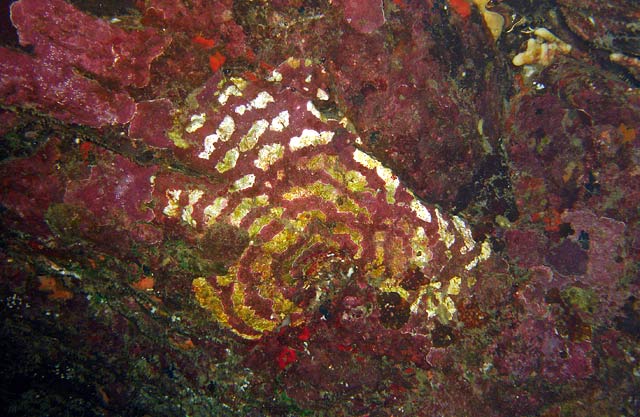
A Coralline Algae Target with thin rings. Approximately 12 inches in diameter. Makena, Maui. Photo: P. Fiene
I guess I knew early-on that these concentric circles were a type of seaweed called crustose coralline algae. What are coralline algae? They are a group of red algae composed of fused plant filaments that have calcareous deposits within and between the cell walls. The crustose coralline algae look like a thin crispy layer, usually pink or purple, covering the surface of a rock.
In my mind all these years, the striking white concentric circles were the crustose coralline algae, and I paid no attention to the uninteresting background. My eyes saw only the white rings.
But I had it all wrong! The living part is the purple-pink background! The white rings, it turns out, are where the coralline algae has been killed. To finally learn this is poetic justice because I have always been amused when my divers think that bright white coral colonies are extra beautiful, when in reality they have just been killed and the white is the bare coral skeleton.
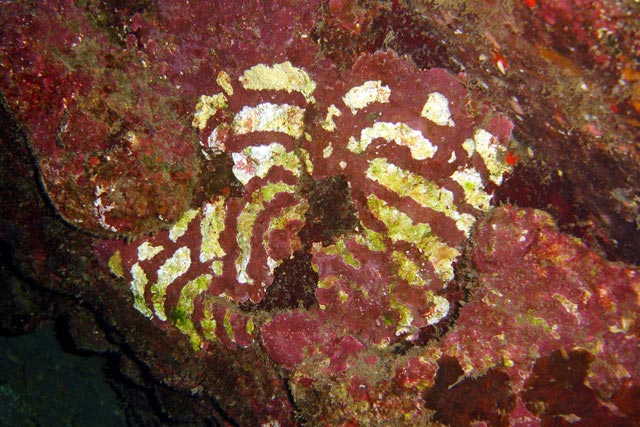
Coralline Algae Target with thicker rings. About 12 inches in diameter. Makena, Maui. Photo by P. Fiene
This white ring disease (or complex of diseases?) was named “Coralline Target Phenomena” by Smithsonian coral reef scientists Mark Littler, Diane Littler, and Barrett Brooks in a short paper they wrote for Reef Encounters in 2007*. In the paper they proposed that the white rings are caused by an unknown agent (a bacterium, group of bacteria or other pathogen) that kills the pink coralline algae filaments in discrete concentric strips leaving just the white calcareous part exposed.
They did not have the opportunity to observe a target over time, so they made an educated guess at an explanation hoping that it would elicit information from colleagues. Whatever the agent causing the disease, they hypothesized that the pathogen kills a strip and then “leap frogs” over living tissue to infect ever-larger bands as the circle increases in diameter.
I contacted one of the authors, Barrett Brooks in the Botany Dept. of the Smithsonian, to find out if he knew of any new studies or information on the subject. He replied, “The phenomenon is still entirely open for study. No one, to my knowledge, has focused additional study into the matter.”
He also offered some additional comments to clarify what is known and not known: “Although bacteria were found present in the targets, they could be a result of some lethal activity, and maybe not the cause. How microbes work on reefs is a huge hole in our knowledge. I’m not entirely sure of the cause proposed, nor am I sure that there is only one cause. There is a range of “targets” from small diameter/thin bands, others large with thicker bands. It certainly looks like the bands travel/radiate outward, but who knows… The full answer is still out there.”
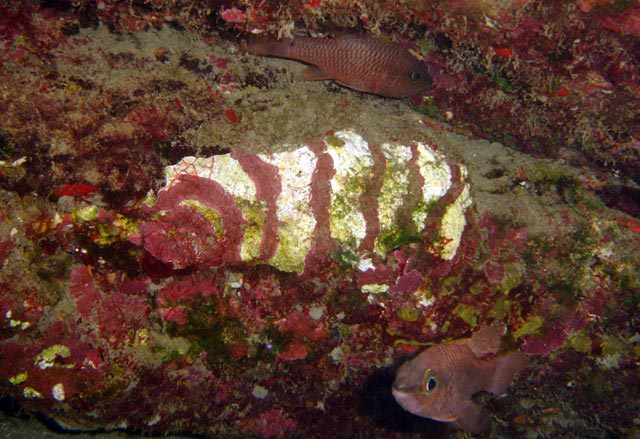
A Coralline Algae Target with thick rings. Makena, Maui. Photo: P. Fiene
Next in my search for a possible explanation I asked marine biologist Cory Pittman and he offered this tentative hypothesis for how the bands might form:
“Assuming the cause is microbial (not necessarily bacterial – the bacteria could be secondary to an initial infection by something else), I wonder if the pattern might result from an interaction between a microbe and a defensive response by the algae? Assume, for the moment, that the agent colonizes a new patch of its host algae (cyst landing, contact with a vector…) establishing an initial point of infection. A colony spreads out from that point killing the underlying algae. The algae around the colony respond by ramping up production of a defensive chemical until it reaches a high enough concentration to suppress the growth of the microbes. The microbes respond by entering a migratory phase and “crawling” forward until they arrive at algae that hasn’t built up enough of the defensive chemical to resist them. Then, they start to consume tissue, again, until the next band of algae builds up resistance. With repetition this forms the target pattern. Meanwhile, the older, resistant bands of algae may begin to slowly overgrow the dead portions..
That would be analogous to how some terrestrial plants respond to attacks by insects. Neighboring plants sense chemicals released by the attacking insects (or the infected plant) and respond by producing defensive compounds that would be too metabolically expensive to produce all the time, but serve to check the spread of the insects ‘when needed’.”
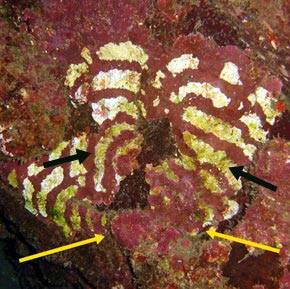
Photo taken at Makena, Maui by P. Fiene
The photos taken in Hawaii provide some clues regarding the progression of the disease over time. First, at the center of the target the coralline algae shows some re-growth over the dead white rings (yellow arrows) indicating that those rings have been there longer and the coralline algae has had time to recover.
Both green micro-algae and young starts of foliose brown (or red?) algae that colonize the dead surfaces are more prominent on the inner rings (black arrows) than on the outer rings, mirroring the progression of the disease and also suggesting that it takes some time (perhaps a matter of weeks?) for the “targets” to reach their full size.
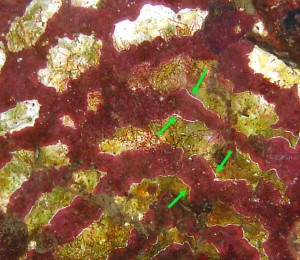
Photo taken at Makena, Maui by P. Fiene.
In our Hawaii photos, the coralline algae surrounding the inner rings is often starting to regrow as indicated by the fine white edges (green arrows). The coralline algae around the outer rings shows no such white edge/active growth.
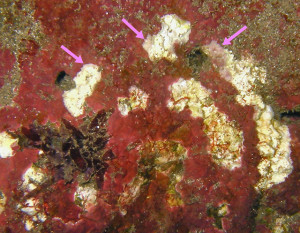
Photo taken at Hekili Point, Maui by Cory Pittman
Also, some portions of the dead surface in the outer rings still retain faint pink pigmentation (pink arrows) suggesting that those patches have recently died. Again, this emphasizes the progressive formation of the “targets.”
In addition to determining the cause of the “targets,” there are many other intriguing questions to address, such as exactly how quickly the bands are formed, what keeps the targets from expanding to more than about a foot in diameter (in Hawaii), do the other species of algae that colonize the dead surface have any influence on the process, does anything relevant happen at night (just in case something else but a microbe is involved)…
With our curiosity now piqued, we will be keeping our eye out for “targets” to monitor and photograph over time.
by Pauline Fiene
*********************
*Mark M. Littler, Diane S. Littler, & Barrett L. Brooks. 2007. Target phenomena on south Pacific reef: strip harvesting by prudent pathogens? Reef Encounter 34:23-24.

Comments 4
Thanks, Pauline and Cory, for figuring this out!
Of course, I realize that you are just putting out some tentative ideas at this point and that little is actually known about these algal patterns. It’s interesting that some lichens produce a similar pattern of concentric rings. In fact, one species is actually called “Target Lichen” or “Concentric Ring Lichen” See this website: http://tinyurl.com/phlcf39 Here is the explanation given: “This lichen has a radial growth pattern. The interior dies back and become recolonized, resulting in a series of expanding, sometime concentric, rings or ring segments. The ring pattern makes this alpine lichen easy to recognize.” Some years ago on Oahu I photographed a lichen with a similar pattern on the cliffs above Waimanalo.
Author
John, I almost included a photo of such a target shape lichen that I saw on Lanai. In answer to a question I sent, Dr. Robert Lucking from the Chicago Field Museum wrote: “This particular pattern is caused by the lichen growing in radiate fashion, with the inner parts dying off (naturally) and then regeneration, so you obtain sort of “growth waves”. Certainly these concentric zones are connected by hyphae but these can only be seen under the microscope. Several lichens have this particular growth pattern, but we have no idea to what advantage.”
It is interesting that the patterns formed by the algae and lichens are similar. But, I suspect the mechanisms of ring formation are different.
In the algae, there are concentric rings of die-back with the oldest ring in the center. In the lichens, there are concentric rings of growth with the oldest ring on the outside.
This is purely speculative, of course. But, taking a crack at a potential rationale for the pattern in the lichens: Start with a lichen expanding over a substrate with maintenance of the living surface dependent on the availability of nutrients in that substrate. Older portions of the patch would, presumably, have used up more of the available nutrients and the central die-back would occur when they were exhausted. Then, regeneration would occur when a new supply of nutrients had accumulated due to the gradual breakdown of the underlying substrate (or the gradual accumulation of nutrient-rich dust?). Expansion of the new central patch as the cycle continued (with repetition over time) would establish the rings. The spacing between the rings could be dependent on the recovery time of the nutrient supply. Alternatively, maybe the hyphae transfer nutrients (or water?) forward from the dead areas to the growing rings with the spacing determined by the area necessary to produce an adequate supply? “Management” of runoff or establishment of a surface texture that promotes capture of nutrient rich dust might also be factors.
Just throwing out a few ideas (that may well have already occurred to others–lichens are well outside my area of expertise)…